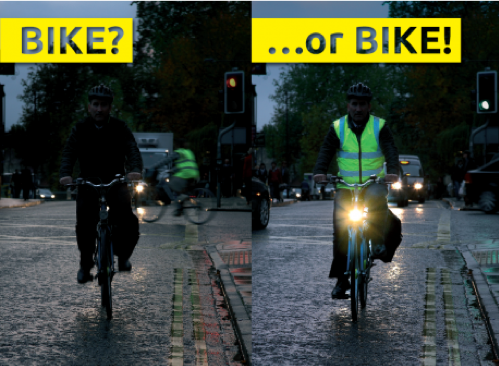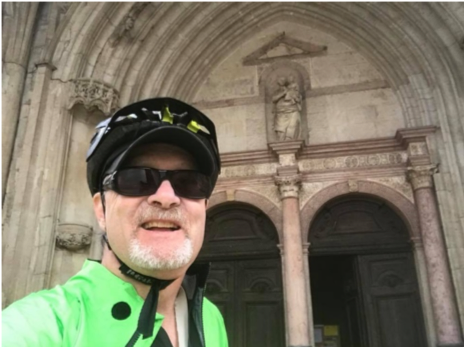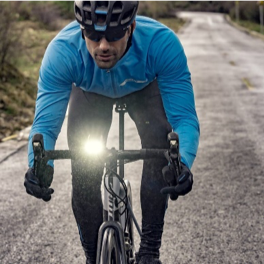Winter weather brings on more challenges than just bundling up on a cold morning or evening ride. Being seen is even more important in the colder months, since it brings fog, cloud cover, rain and shorter daylight times. How many times have you been in a vehicle traveling up Friant or Auberry and have barely noticed from a good distance the person or group of people riding their bikes?
Sometimes I feel that we cyclists think that just because we can see a vehicle while riding our bike, the vehicle must see us. Obviously, this is not true. I have been guilty of it. Traveling in a vehicle at a much higher rate of speed around turns in the foothills can make it very difficult to see a cyclist. There are some ways that we can become more visible to those around us. This not only protects us or the our group we are riding in, it also protects the family who may be riding in the vehicle as well.
While I have a lot of experience within this subject, I felt it was best to reach out to Tony Molina. Tony is the Vice-Chairman for the Fresno County Bicycle Coalition, plus a Certified Instructor with the League of American Bicyclists. He teaches classes that include this very subject. Here’s what Tony had to say:
Smart Cycling for Winter Nights
'Tis the Season of shorter days and longer nights, and for cyclists to be mindful of the modifications to daylight riding that night riding entails. Smart Cycling, the bicycle education program sponsored by the League of American Bicyclists, advises regarding night riding: “It's important to adjust your speed while riding at night as street hazards and obstructions can be harder to see. Nighttime can bring a higher incidence of impaired motorists due to fatigue, poor night vision and alcohol.
Remember that wet roads reduce the effectiveness of headlights. Relatively dim bicycle lights may get lost in a mass of brighter lights, so never assume a motorist has seen you. Even if you have properly equipped yourself and your bicycle for optimum visibility, be aware that you still may not be immediately visible to motorists. Don’t assume they can see you.
Be extra careful at intersections and when making left turns. Do not get caught in an intersection as the light turns red. Slow down if necessary, so you can stop on the yellow. If you must wait for oncoming traffic before turning left, stop before entering the intersection (not in it, as you would in daylight).
Most state laws require a headlight and red rear reflector for riding from dusk until dawn. Dirty reflectors and lights lose effectiveness. What lighting you select depends on your riding environment (lighted city streets, dark rural roads, etc.) and conditions (rain, fog, etc.) Lights can be either battery or generator powered. Regardless of the type of light you select, remember to carry a spare or extra battery. Not having a spare could make for a dark, dangerous ride. It's a good idea to take a nighttime test once you have your bicycle equipped. Have someone else ride your night-equipped bike as you would, to see how easily they can be seen. Then make any necessary adjustments for optimum visibility. Reflector vests provide additional visibility during the night.
During darkness, bicyclists should avoid wearing dark clothing and be aware that California DMV Code 21201 requires all four of the following for legal night time riding:
- A front lamp emitting a white light visible from a distance of 300 feet from the front and sides, which may be attached either to the bicycle or bicyclist.
- A rear red reflector or a solid or flashing red light with a built-in reflector visible from a distance of 500 feet.
- A white or yellow reflector on each pedal or on the bicyclist’s shoes or ankles visible from the front and rear at a distance of 200 feet.
- A white or yellow reflector on the front wheel, a white or red reflector on the rear wheel, or a white to the front and red to the rear of the bike reflectors or reflectorized tires.
-Tony Molina
Thank you, Tony! Bright and visible clothing is extremely important. In the winter, a high visibility color like yellow, orange, or green will draw a lot of attention to you and force people to be aware of your presence. In the evening or low visibility situations we want to make sure we have on as many reflective items as we can. We want to light up when a vehicles lights shine on us. The single best place to have reflective pieces is on our feet or our ankles: the moving of the reflector will increase our visibility significantly. Other places that need to have reflective pieces on them are on your jersey, bibs, seat bag, shoes, gloves, tires, your bike, helmet, jacket or warmers and basically anywhere you can put one. Most manufacturers (like Giant and Liv for example) include reflective logos on their winter apparel. In the daytime the logos look normal, but when the light hits them, they reflect light and really make us visible.
Using headlights and taillights (both day and night)  will significantly increase your visibility. Make sure your lights are charged, and in the daytime run on a flash setting. In foggy conditions having an extremely bright light, upwards of 30 lumens for the rear, will allow motorists to spot you from a great distance. The combination of lights you use should be seen from every direction around you. Don’t be the person holding his cell phone up and using it as a light: it doesn’t work very well. Headlights on a vehicle are around 1200 or so lumens. Keep in mind how hard it is to see those lights from a distance in the fog. If you can have a dedicated front light on as a beam and a high lumen count (900+) in the fog, you stand a very good chance of being seen from a safe distance. Don’t assume people see you in severe conditions, because they just may not.
will significantly increase your visibility. Make sure your lights are charged, and in the daytime run on a flash setting. In foggy conditions having an extremely bright light, upwards of 30 lumens for the rear, will allow motorists to spot you from a great distance. The combination of lights you use should be seen from every direction around you. Don’t be the person holding his cell phone up and using it as a light: it doesn’t work very well. Headlights on a vehicle are around 1200 or so lumens. Keep in mind how hard it is to see those lights from a distance in the fog. If you can have a dedicated front light on as a beam and a high lumen count (900+) in the fog, you stand a very good chance of being seen from a safe distance. Don’t assume people see you in severe conditions, because they just may not.
The reality of riding on the road in less-than-perfect conditions needs to be taken seriously. We, as the Fresno Cycling Club, represent a large amount of the cyclists in the greater Fresno area. We should be well-equipped and represent ourselves in high regard when it comes to safety. We need to be prepared to ride in whatever the day’s conditions are. If not, it’s not worth the risk.
-Devin Bovee
Devin@stevensbicycles.com
559.797.0148
